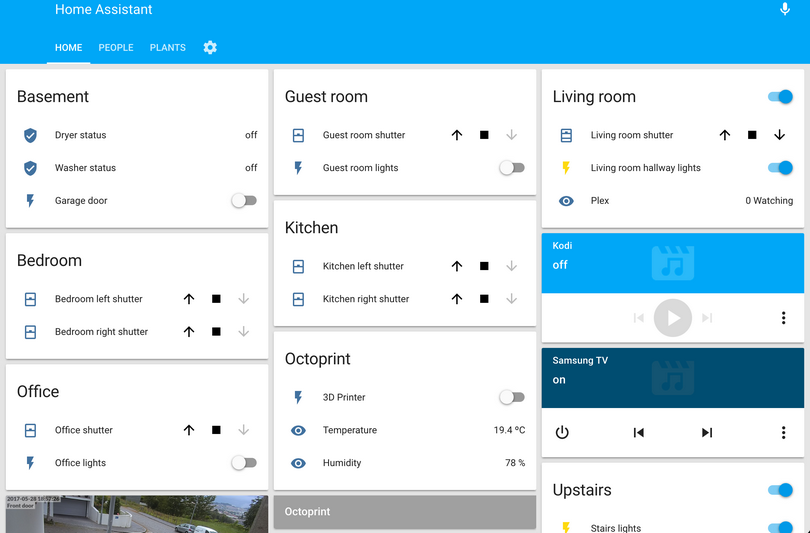 Versie 0.98 Home Assistant is kort geleden uitgebracht en inmiddels is er ook alweer een kleine update verschenen. Home Assistant is een opensourceplatform voor home-automation dat draait onder Python 3. Het draait via Hassbian op een Raspberry Pi 3 of een Linux-, macOS- of Windows-computer. Het ondersteunt het detecteren van apparaten, zoals Nest-thermostaten, Philips Hue, Belkin WeMo-schakelaars, Mr. Coffee-koffiezetapparaten, de slimme schakelaars van IKEA en het mqtt-protocol. Daarnaast kan het waar mogelijk deze apparaten aansturen en automatisering toepassen. Voor meer informatie verwijzen we naar deze pagina en ons Forum. De releasenotes voor deze uitgave zijn hieronder te vinden.
Versie 0.98 Home Assistant is kort geleden uitgebracht en inmiddels is er ook alweer een kleine update verschenen. Home Assistant is een opensourceplatform voor home-automation dat draait onder Python 3. Het draait via Hassbian op een Raspberry Pi 3 of een Linux-, macOS- of Windows-computer. Het ondersteunt het detecteren van apparaten, zoals Nest-thermostaten, Philips Hue, Belkin WeMo-schakelaars, Mr. Coffee-koffiezetapparaten, de slimme schakelaars van IKEA en het mqtt-protocol. Daarnaast kan het waar mogelijk deze apparaten aansturen en automatisering toepassen. Voor meer informatie verwijzen we naar deze pagina en ons Forum. De releasenotes voor deze uitgave zijn hieronder te vinden.
0.98: Improved entity management, options and Home Assistant AlertsIt’s time for the 0.98 release. As Home Assistant grows, some features will sometimes be left partially implemented, leaving things to be desired. In this release we’ve been focusing on tieing up these loose ends, sometimes with new features. Getting better all the time!
Entity ManagementOne of the things that we’ve been improving in this release is entity management. Historically we’ve let this up to integrations, but that caused users to learn multiple ways and more work for integration developers.
Generally entity management is not that important, you want all the entities created by your integrations! However this was less the case when we started migrating over device trackers. This became clear when we migrated over Unifi.
So in this release we’re introducing a couple of new features that are available for all entities in the entity registry and integrations that are set up via config entries.
The first feature is that it’s now possible to disable entities. If an entity is disabled, it will not be added to Home Assistant when an integration adds it. So now it will be easy to manage which entities will show up. This option is accessible from the entity registry
The second feature is a new option to automatically disable any new entities that an integration discovers. In the case of a device tracker, newly connected devices to the network won’t be added anymore. This option is accessible from the integration details page via a button on the toolbar at the top.
With these two features we are now at feature parity with the filtering features that are available in the device tracker integration. Next step will be polishing of the person integration to get all those shiny new device tracker entities under one roof.
Config Entry OptionsWe introduced config entries last year as our way as a generic way for integrations to store authentication and configuration. By allowing integrations to define the storage format, there are no more breaking changes for anything stored inside config entries!
Config entries also work great with people who prefer configuration.yaml. At startup a config entry is created/updated with the configuration.
With this release @kane610 added a new possibility for integrations to offer options in the UI. Options that previously required you to edit configuration.yaml can now be offered via the interface.
This release adds config entry options to Deconz and Unifi integrations with many more to come.
Home Assistant AlertsDevices and services can receive updates that can cause integrations to break. This is frustrating and sometimes the cause can be hard to track down. Usually the users on forums/chat are aware and can help redirect people in the right direction, but that’s not a scalable solution!
So to combat this, we’re launching Home Assistant Alerts. Home Assistant Alerts is a website that will track known issues and explains in user friendly language what is going on. Alerts can be tagged with applicable Home Assistant versions, integrations and Python packages.
In the future we’re planning on integrating this directly in Home Assistant, so that users can be pro-actively notified of issue related to their configuration.
Docker base image changeIf you run Home Assistant via Docker (not Hass.io) and are using the
homeassistant/home-assistantcontainer, the images are now using the same images as hass.io, which are using Alpine Linux instead of Debian.The hass.io images are a third of the size of the old images and are heavily optimized thanks to the hard work by @pvizeli.
This change will only impact you if you were extending or customizing the image with Debian packages. If you want to continue to use the Debian based images, you can find the Dockerfile for the old images here.
For more background on this decision, see ADR-006.
WebscrapingWith this release we have deprecated integrations that rely on webscraping. These will be removed from Home Assistant in a future release. Our scrape integration will remain part of Home Assistant.
Webscraping is fragile, breaks often requires frequent updates and there have been occassions where websites have banned our users.
Users that rely on these integrations can continue using them as custom components.
For more background on this decision, see ADR-004.
New IntegrationsNew Platforms
- Add Plugwise component (@CoMPaTech - #25533) (plugwise docs) (new-integration)
- GeoNet NZ Quakes feed integration (@exxamalte - #25736) (geonetnz_quakes docs) (new-integration)
- Add Keba charging station/wallbox as component (@dannerph - #24484) (keba docs) (new-integration)
- Add Minio component (@tkislan - #23567) (minio docs) (new-integration)
- Add ring switch platform (@rossdargan - #25612) (ring docs) (new-platform)
- Add ring light platform (@rossdargan - #25733) (ring docs) (new-platform)
- Expose Lutron RA2 occupancy sensors (@achatham - #25854) (lutron docs) (new-platform)


:fill(white):strip_exif()/i/2006976478.jpeg?f=thumbmedium)